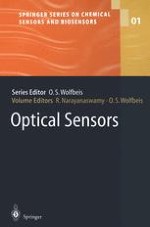2004 | OriginalPaper | Buchkapitel
Surface Plasmon Resonance Biosensors for Food Safety
verfasst von : Jiří Homola
Erschienen in: Optical Sensors
Verlag: Springer Berlin Heidelberg
Enthalten in: Professional Book Archive
Aktivieren Sie unsere intelligente Suche, um passende Fachinhalte oder Patente zu finden.
Wählen Sie Textabschnitte aus um mit Künstlicher Intelligenz passenden Patente zu finden. powered by
Markieren Sie Textabschnitte, um KI-gestützt weitere passende Inhalte zu finden. powered by
Technology for early detection and identification of biological substances is urgently needed in fields such as environmental protection, biotechnology, medicine, and food and drug screening. In the United States, foodborne illnesses caused by chemical contaminants, toxins and bacterial pathogens result in medical and lost productivity costs of up to $ 22 billion annually [1]. Therefore, detection of food safety-related substances is of paramount importance to food producers, processors, distributors and regulatory agencies. Although numerous detection methods have been developed and implemented in centralized testing sites (high performance liquid chromatography, gas chromatography mass spectroscopy, culturing including Gram-staining and microscopic examination, etc.), the intensive search for cost-effective and practical methods capable of detecting very low concentrations of chemical contaminants, toxins and bacterial pathogens in food samples in the field continues. In recent years, various sensor technologies have been developed (electrochemical sensors [2], piezoelectric sensors [3], electrical impedance sensors [4], optical sensors [5]) and tested for detection of analytes implicated in food safety [6, 7]. Optical sensors offer several important advantages. The performance of optical sensors is insensitive to electromagnetic interference. In addition, optical sensors do not require electrical signals in the sensing area and therefore can be operated in hazardous environments of industrial plants. Several types of optical biosensors have been demonstrated for detection of chemical contaminants, bacterial pathogens and toxins in food. These include fluorescence-based sensors [8], grating coupler sensors [9], resonant mirror sensors [10], and surface plasmon resonance (SPR) sensors [11]. The fluorescence-based sensors offer high sensitivity, but due to the use of labels, they require either multi-step detection protocols resulting in longer detection times or delicately balanced affinities of interacting biomolecules for displacement assays [12] causing sensor cross-sensitivity to non-target analytes. Grating coupler, resonant mirror and SPR sensors are label-free sensor technologies and thus, in principle, allow for direct and continuous detection.
